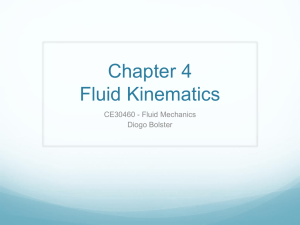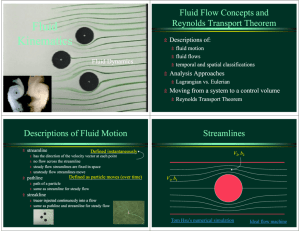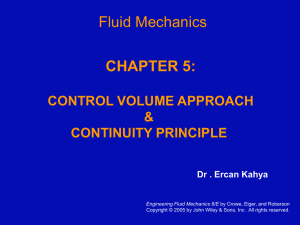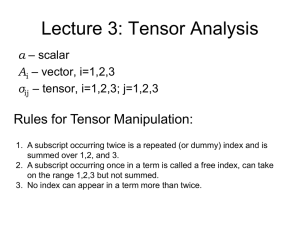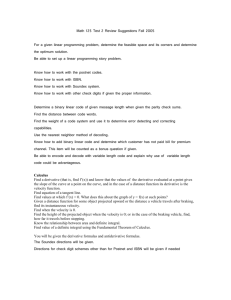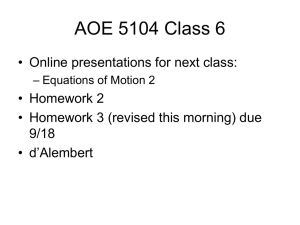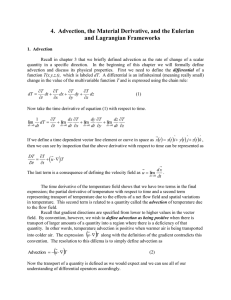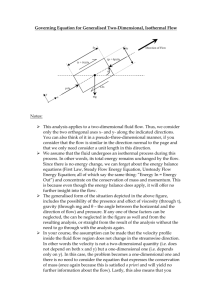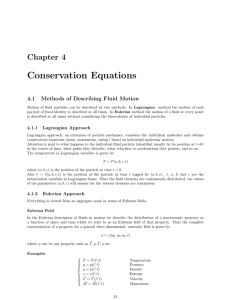1 3. MASS CONSERVATION AND THE EQUATION OF
advertisement
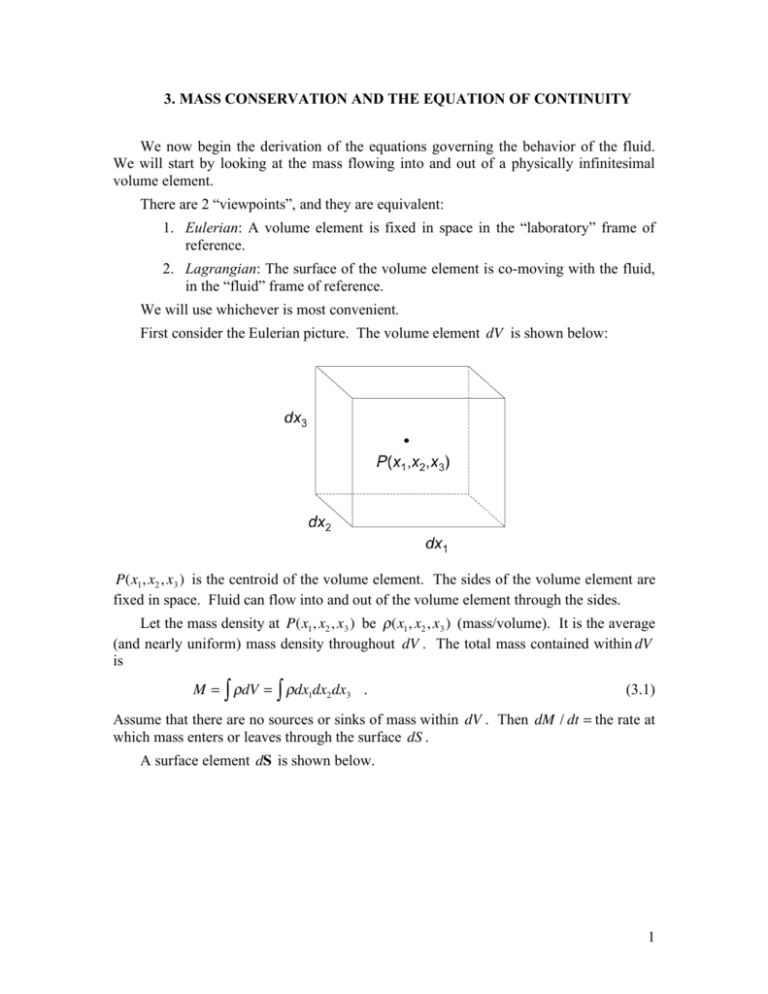
3. MASS CONSERVATION AND THE EQUATION OF CONTINUITY
We now begin the derivation of the equations governing the behavior of the fluid.
We will start by looking at the mass flowing into and out of a physically infinitesimal
volume element.
There are 2 “viewpoints”, and they are equivalent:
1. Eulerian: A volume element is fixed in space in the “laboratory” frame of
reference.
2. Lagrangian: The surface of the volume element is co-moving with the fluid,
in the “fluid” frame of reference.
We will use whichever is most convenient.
First consider the Eulerian picture. The volume element dV is shown below:
P(x1 , x2 , x3 ) is the centroid of the volume element. The sides of the volume element are
fixed in space. Fluid can flow into and out of the volume element through the sides.
Let the mass density at P(x1 , x2 , x3 ) be !(x1 , x2 , x3 ) (mass/volume). It is the average
(and nearly uniform) mass density throughout dV . The total mass contained within dV
is
!M = " !dV = " !dx1dx2 dx3 !!!.
(3.1)
Assume that there are no sources or sinks of mass within dV . Then dM / dt = the rate at
which mass enters or leaves through the surface dS .
A surface element dS is shown below.
1
The surface area is dS , and n̂ is a unit vector normal (perpendicular) to the surface (in an
average sense). When dS is a side of a volume element dV , n̂ is assumed to point out
of the volume element (i.e., from inside to outside). The flux of mass (mass/unit
area/unit time) passing through a surface is !V , where V is the fluid velocity. It is a
vector quantity (actually, a pseudovector, because of the presence of ! ). Then the mass
per unit time flowing through dS is !V " dS = !V " n̂dS , and the total rate of flow of
mass out of the volume dV is
# !V " dS $ !% !V " dS = !% !V " n̂dS !!!,
Faces
S
(3.2)
S
where the integral is over the surface enclosing dV .
!dM / dt , we have
dM d
= " !dV = # !
"S !V $ n̂dS !!!.
dt
dt V
Since this must be equal to
(3.3)
For a fixed (Eulerian) surface, we can take the total time derivative inside the volume
integral as a partial derivative:
!"
# !t dV = $ !# "V % n̂dS !!!.
V
(3.4)
S
By Gauss’ theorem,
!# !V " n̂dS = # $ " ( !V ) dV !!!,
S
(3.5)
V
so that
% !"
+ '& !t
V
(
+ # $ ( "V ) * dV = 0!!!.
)
(3.6)
This expression must hold for every arbitrarily shaped volume; the only way that it can
be satisfied is if the integrand vanishes identically, or
!"
= #$ % ( "V )!!!!.
!t
(3.7)
This is called the continuity equation. It expresses conservation of mass in the Eulerian
frame of reference.
2
We remark that Equation (3.7) is a partial differential equation with four dependent
variables: ! and the three components of V . If the velocity were known a priori, the
system would be closed and we could solve Equation (3.7) for the evolution of ! .
Problems in which the velocity field is fixed, or specified in a advance, are call kinematic.
Problems where V s determined from other physical principles are called dynamic, and
the latter is the case of interest here. We therefore have 3 more unknowns than we have
equations; the problem is not closed. This problem of closure is of fundamental
importance in MHD, and we will discuss it in more detail later in this course.
We now describe conservation of mass in the Lagrangian picture. Here the volume
element dV is co-moving with the fluid, as sketched in the figure below:
Every point on the surface and within the volume is moving with the local velocity
V = dx / dt ; the coordinates of each “bit” of the volume element are thus time dependent:
xi = xi (t) . The shape of the volume element can distort with time. However, since each
point on the boundary S moves with the fluid, no fluid can flow across the surface, so
that the total mass within the volume element is fixed in time: dM / dt = 0 , and mass is
automatically conserved.
However, things are still complicated. As the volume element moves through space,
it’s total mass, as given by Equation (3.1), remains constant, but since the total volume of
the element can change as it distorts due to fluid motions, the mass density must be
considered to be a function of time. Conservation of mass is then stated as
dM
d
= 0 = " !(t)dx1 (t)dx2 (t)dx3 (t)!!!!.
dt
dt V
(3.8)
So, we not only need to calculate the change in ! , but we need to account for the change
in the volume dV as it moves through space.
3
To this end we introduce a “new” infinitesimal, ! xi . The infinitesimal operator ! is
taken to operate only on the spatial coordinates xi ; the notation is reserved to time. In all
other respects, d and ! are the same. Equation (3.8) is written as
d
!(t)" x1 (t)" x2 (t)" x3 (t) = 0!!!,
dt V#
(3.9)
and the time dependence of the coordinates is given by
dxi
= Vi !!!.
dt
(3.10)
Now time is the only independent variable. Differentiating under the integral sign in
Equation (3.9), we have
d
# d!
&
0 = ) % " x1" x2" x3 + ! (" x1" x2" x3 ) ( !!!,
dt
$ dt
'
d" x2
d" x3 & * d!
# d" x1
!!= ) + " x1" x2" x3 + ! %
" x2" x3 + " x1
" x3 + " x1" x2
.!!!,
dt
dt (' /
$ dt
, dt
) d!
# "V "V "V & ,
!!= / + " x1" x2" x3 + !" x1" x2" x3 % 1 + 2 + 3 ( . !!!,
$ "t
"t
"t ' * dt
(3.11)
where we have used the fact that ! and d are both infinitesimals, along with Equation
(3.10), to write d(! xi ) / dt = ! (dxi / dt) = !Vi . We recognize the last term in brackets as
! " V . Then writing dV = ! x1! x2! x3 ,
$ d!
'
0= *&
+ !" # V ) dV !!!!.
% dt
(
(3.12)
As with Equation (3.6), since this must hold for arbitrary volume elements we require
d!
+ !" # V = 0!!!!.
dt
(3.13)
This is the expression for conservation of mass in the Lagrangian frame of reference.
Equation (3.13), the Lagrangian expression, appears to be different from Equation
(3.7), the Eulerian expression. In particular, how are we to interpret the total time
derivative d / dt that appears in Equation (3.13)? Since these equations each express the
law of conservation of mass, they must be consistent. Note that we can write Equation
(3.7) as
!"
!"
+ # $ ( "V ) =
+ V $ #" + "# $ V = 0!!!!,
!t
!t
(3.14)
which will be consistent with Equation (3.13) if we identify
d ! "!
=
+ V # $! !!!.
dt
"t
(3.15)
4
Generally, the operator d / dt = ! / !t + V " # is called the total time derivative, or the
Lagrangian derivative. It measures the total change in a quantity associated with a fluid
element as it moves about in space. This can be seen as follows. The Lagrangian change
in the density in a time dt consists of two parts, d ! = d !1 + d !2 , where d !1 is the
change in ! during dt at a fixed point in space,
d !1 =
"!
dt !!!,
"t
(3.16)
and d !2 is the difference between densities separated by a distance dx , at the same time
t,
d !2 = dx " #! !!!.
(3.17)
The total change in ! is therefore
d! =
"!
dt + dx # $! !!!,
"t
(3.18)
so that
d ! "!
=
+ V # $! !!!.!
dt
"t
(3.19)
Of course, this result can also be obtained formally by applying the chain rule to
! = ! [ x(t),t ] , i.e.,
d ! "! "! dx "!
=
+
#
=
+ V # $! !!!,
dt
"t "x dt "t
but this provides little physical insight.
The term V ! "# is called the advective derivative. The terminology originated in
weather and climate modeling, where convection refers to vertical uplift driven by
buoyancy and thermal forces, and advection refers to wind driven horizontal transport.
The terminology has carried over to MHD, where it refers to all velocity driven transport.
Its origin is illustrated in the figure below:
5
The profile !(x) is being carried to the right with velocity V = dx / dt ; in a time ! t it is
carried a distance V ! t . The change in ! in a time ! t at a fixed point x0 is just
!" = #($" / $x)V ! t , or d ! / dt = "V # $! .
The term ! "# $ V measures the change in ! due to compression or dilation of the
fluid element. This is illustrated in the figure below:
In the figure on the left, ! " V > 0 , the flow is diverging, there is net flow out of the
volume element, and the mass within the volume element is decreasing. In the figure on
the right, ! " V < 0 , the flow is converging, there is net flow into the volume element,
and the mass within the volume element is increasing.
The continuity equation and conservation of mass are exactly the same in
hydrodynamics and MHD.
6
